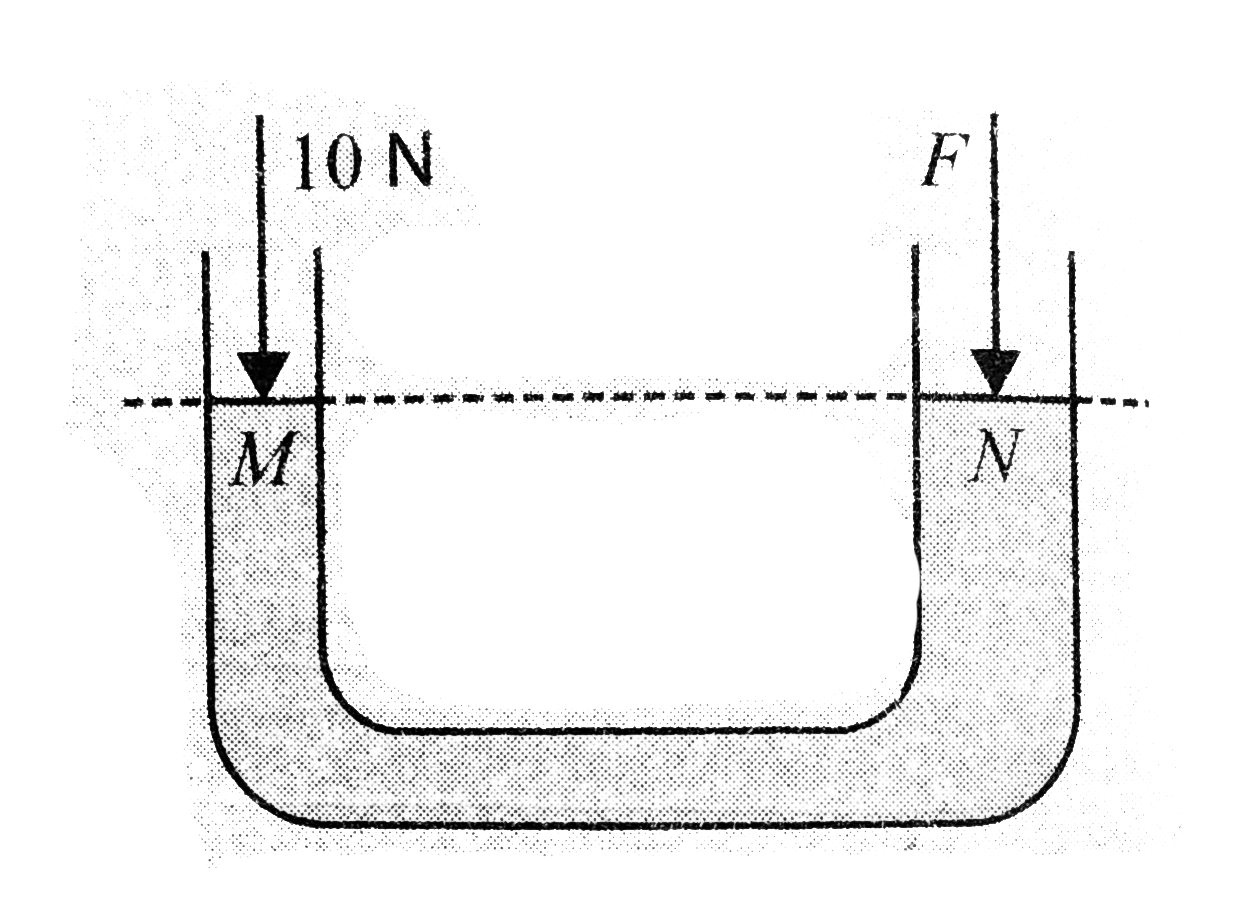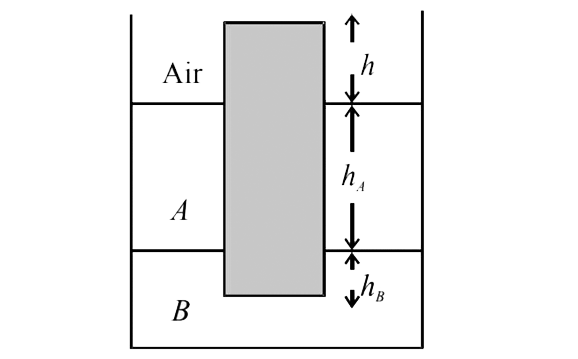(a) The diameter of neck and bottom of a bottle are 2 cm and 10 cm respectively. The bottle is completely filled with oil. If the cork in the neck is pressed in with a force of 1.2kgf , what force is exerted on the bottom of the bottle ?
(b) Name the law/ principle you have used to find the force in part (a)
The correct Answer is:(a) 30 kgf
(b) Pascal's law
To solve the problem step by step, we will follow these calculations:
Step 1: Determine the radius of the neck and the bottom of the bottle.
- The diameter of the neck is given as 2 cm, so the radius (r₁) of the neck is:
r₁=2 cm2=1 cm
- The diameter of the bottom is given as 10 cm, so the radius (r₂) of the bottom is:
r₂=10 cm2=5 cm
Step 2: Calculate the area of the cork (neck).
- The area (A₁) of the cork can be calculated using the formula for the area of a circle:
A₁=πr₁2=π(1 cm)2=π cm2
Step 3: Calculate the pressure applied by the cork.
- The force applied on the cork is given as 1.2 kgf. To find the pressure (P₁) exerted by the cork, we use the formula:
P₁=ForceArea=1.2 kgfA₁=1.2 kgfπ cm2
Step 4: Calculate the area of the bottom of the bottle.
- The area (A₂) of the bottom can be calculated similarly:
A₂=πr₂2=π(5 cm)2=25π cm2
Step 5: Use Pascal's Law to find the force at the bottom of the bottle.
- According to Pascal's Law, the pressure at the cork is equal to the pressure at the bottom of the bottle:
P₁=P₂
- Therefore, we can set up the equation:
1.2 kgfπ cm2=F25π cm2
- Here, F is the force exerted at the bottom of the bottle. Rearranging gives:
F=1.2 kgf×25π cm2π cm2=1.2×25 kgf=30 kgf
Final Answer:
(a) The force exerted on the bottom of the bottle is 30 kgf.
(b) The principle used to find the force in part (a) is Pascal's Law.
---
- The diameter of the neck is given as 2 cm, so the radius (r₁) of the neck is:
r₁=2 cm2=1 cm
- The diameter of the bottom is given as 10 cm, so the radius (r₂) of the bottom is:
r₂=10 cm2=5 cm
- The area (A₁) of the cork can be calculated using the formula for the area of a circle:
A₁=πr₁2=π(1 cm)2=π cm2
- The force applied on the cork is given as 1.2 kgf. To find the pressure (P₁) exerted by the cork, we use the formula:
P₁=ForceArea=1.2 kgfA₁=1.2 kgfπ cm2
- The area (A₂) of the bottom can be calculated similarly:
A₂=πr₂2=π(5 cm)2=25π cm2
- According to Pascal's Law, the pressure at the cork is equal to the pressure at the bottom of the bottle:
P₁=P₂
- Therefore, we can set up the equation:
1.2 kgfπ cm2=F25π cm2
- Here, F is the force exerted at the bottom of the bottle. Rearranging gives:
F=1.2 kgf×25π cm2π cm2=1.2×25 kgf=30 kgf
(a) The force exerted on the bottom of the bottle is 30 kgf.
Topper's Solved these Questions
- BOOK - ICSECHAPTER - PRESSURE IN FLUIDS AND ATMOSPHERIC PRESSUREEXERCISE - Exercise -4(B)31videos
PRESSURE IN FLUIDS AND ATMOSPHERIC PRESSURE
- BOOK - ICSECHAPTER - PRESSURE IN FLUIDS AND ATMOSPHERIC PRESSUREEXERCISE - Exercise -4(B)Multiple choice3videos
PRESSURE IN FLUIDS AND ATMOSPHERIC PRESSURE
- BOOK - ICSECHAPTER - PRESSURE IN FLUIDS AND ATMOSPHERIC PRESSUREEXERCISE - Exercise-4(A)numericals10videos
PRESSURE IN FLUIDS AND ATMOSPHERIC PRESSURE
- BOOK - ICSECHAPTER - MOTION IN ONE DIMENSION EXERCISE - EXERCISE -2 (C) ( Multiple choice type :)17videos
MOTION IN ONE DIMENSION
- BOOK - ICSECHAPTER - PROPAGATION OF SOUND WAVES EXERCISE - EXERCISE -8(B) (Multiple choice type)3videos
PROPAGATION OF SOUND WAVES
Similar Questions
The neck and bottom of a bottle are 3 cm and 15 cm in radius respectively. If the cork is pressed with a force 12 N in the neck of the bottle, then force exerted on the bottom of the bottle is :-
View SolutionThe area of cross section of the two arms of a hydraulilc press are 1 cm^2 and 10 cm^2 respectively figure. A force of 5N is applied on the water in the thinner arm. What force should be applied on the water in the thicker arm so that the water may remain in equilibrium?
 ,View Solution
,View SolutionThe area of cross sectioin of the two arms of a hydraulic press is 1cm2 and 20cm2 respectively. A force of 10N is applied on the water in the thinner arm. What force should be applid on the water in the thicker arms so that water may remain in equilibrium?
 View Solution
View SolutionThe area of cross section of the two arms of a hydraulilc press are 1 cm^2 and 10 cm^2 respectively figure. A force of 5N is applied on the water in the thinner arm. What force should be applied on the water in the thicker arm so that the water may remain in equilibrium?
 ,View Solution
,View SolutionIn an arrangement similar to a hydraulic lift, the diameters of smaller and larger pistons are 1.0 cm and 3.0 cm respectively. What is the force exerted on the larger piston when a force of 10 N is applied to the smaller piston?
View SolutionA bucket has top and bottom diameters of 40 cm and 20 cm respectively. Find the volume of the bucket if its depth is 12 cm. Also, find the cost of tin sheet used for making the bucket at the rate of Rs 1.20 per cm2 .
View SolutionA uniform solid cylinder of density 0.8g/cm3 floats in equilibrium in a combination of two non-mixing liquids A and B with its axis vertical.
The densities of the liquids A and B are 0.7g/cm3 and 1.2g/cm3, respectively. The height of liquid A is hA=1.2cm. The length of the part of the cylinder immersed in liquid B is hB=0.8cm.

(a) Find the total force exerted by liquid A on the cylinder.
(b) Find h, the length of the part of the cylinder in air.
(c) The cylinder is depressed in such a way that its top surface is just below the upper surface of liquid A and is then released. Find the acceleration of the cylinder immediately after it is released.View SolutionA uniform solid cylinder of density 0.8g/cm3 floats in equilibrium in a combination of two non-mixing liquids A and B with its axis vertical.
The densities of the liquids A and B are 0.7g/cm3 and 1.2g/cm3, respectively. The height of liquid A is hA=1.2cm. The length of the part of the cylinder immersed in liquid B is hB=0.8cm.

(a) Find the total force exerted by liquid A on the cylinder.
(b) Find h, the length of the part of the cylinder in air.
(c) The cylinder is depressed in such a way that its top surface is just below the upper surface of liquid A and is then released. Find the acceleration of the cylinder immediately after it is released.View SolutionA uniform solid cylinder of density 0.8g/cm3 floats in equilibrium in a combination of two non-mixing liquids A and B with its axis vertical.
The densities of the liquids A and B are 0.7g/cm3 and 1.2g/cm3, respectively. The height of liquid A is hA=1.2cm. The length of the part of the cylinder immersed in liquid B is hB=0.8cm.

(a) Find the total force exerted by liquid A on the cylinder.
(b) Find h, the length of the part of the cylinder in air.
(c) The cylinder is depressed in such a way that its top surface is just below the upper surface of liquid A and is then released. Find the acceleration of the cylinder immediately after it is released.View SolutionA metallic cube of side 10 cm is subjected to a shearing force of 300 kgf. The top force is displaced through 0.25 cm with respect ot the bottom ? Calculate the shearing strain produced .
View Solution

